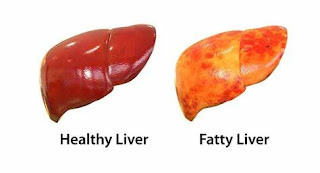how to get rid of fatty liver:
Adopt a healthy diet: Focus on eating whole foods, including fruits and vegetables, lean proteins, whole grains, and healthy fats. Avoid processed foods, sugary drinks, and excessive amounts of alcohol.
Lose weight: Losing weight can help reduce the amount of fat in your liver. Aim for a slow and steady weight loss of 1-2 pounds per week through a combination of diet and exercise.
Exercise regularly: Engage in physical activity for at least 30 minutes a day, most days of the week. Aim for a combination of aerobic exercise, such as brisk walking, and strength training.
Limit alcohol consumption: If you drink alcohol, limit your intake to no more than one drink a day for women and two drinks a day for men.
Manage underlying conditions: If you have underlying medical conditions, such as type 2 diabetes or high cholesterol, work with your healthcare provider to manage these conditions effectively.
Avoid medications that can worsen liver function: Talk to your doctor about any medications you are taking, as some can worsen liver function.
It is important to note that recovery from fatty liver may take time, and the specific steps you need to take may vary depending on the underlying cause of your condition. Consult a healthcare professional for a personalized treatment plan..
The main treatment for fatty liver disease is lifestyle changes, including:
In addition to lifestyle changes, your doctor may also recommend medication to help manage the condition, including:
Statins: Statins can help reduce the amount of fat in the liver and improve liver function.
Antioxidants: Antioxidants, such as Vitamin E, can help reduce inflammation and protect the liver from further damage.
Insulin sensitizers: Medications such as metformin can help improve insulin sensitivity and reduce the risk of liver damage.
It's important to note that the best way to treat fatty liver disease is to prevent it from developing in the first place. Maintaining a healthy weight, eating a balanced diet, and avoiding excessive alcohol consumption can help protect your liver and reduce the risk of developing fatty liver disease.
how can a person diagnosed fatty liver:
The most commonly used imaging procedures for fatty liver are:
Ultrasound:
An ultrasound is a non-invasive test that uses high-frequency sound waves to create images of the liver and surrounding tissues. It's a quick and painless way to check for the buildup of fat in the liver.
CT (Computed Tomography) scan:
CT scans use X-rays and computer technology to produce detailed images of the liver and surrounding tissues. This test can show the presence of fat in the liver and help determine the amount and distribution of the fat.
MRI (Magnetic Resonance Imaging): MRI uses a powerful magnetic field, radio waves, and a computer to produce detailed images of the liver and surrounding tissues. This test can also show the presence of fat in the liver and help determine the amount and distribution of the fat.
Your doctor will recommend the most appropriate imaging procedure based on your individual circumstances, including your overall health and medical history, as well as the specific symptoms you're experiencing.
Liver biopsy:
A liver biopsy is a diagnostic procedure in which a small sample of liver tissue is taken for examination under a microscope. This can confirm the presence of fatty liver and determine the extent and type of liver damage.
Liver tissue examination for fatty liver involves a procedure called a liver biopsy. During a liver biopsy, a small sample of liver tissue is removed and examined under a microscope to determine the extent and type of liver damage.
Here's how the procedure works:
Preparation: Before the procedure, you may need to fast for several hours and stop taking certain medications that can affect blood clotting.
Procedure: A liver biopsy is usually performed using a thin, needle-like device that's inserted through the skin into the liver. The needle is usually guided by ultrasound, CT scan or MRI to ensure it reaches the right area of the liver. A small sample of liver tissue is then removed and sent to a laboratory for analysis.
Analysis: The liver tissue is examined under a microscope to determine if there is an accumulation of fat in the liver, as well as the extent and type of liver damage.
Results: The results of the liver biopsy can help diagnose fatty liver disease and determine its severity. The results can also help your doctor develop an appropriate treatment plan.
It's important to note that a liver biopsy is a relatively safe procedure, but there is a small risk of bleeding, infection, or injury to the liver. Your doctor will discuss the risks and benefits of the procedure with you and help you make an informed decision.



0 Comments